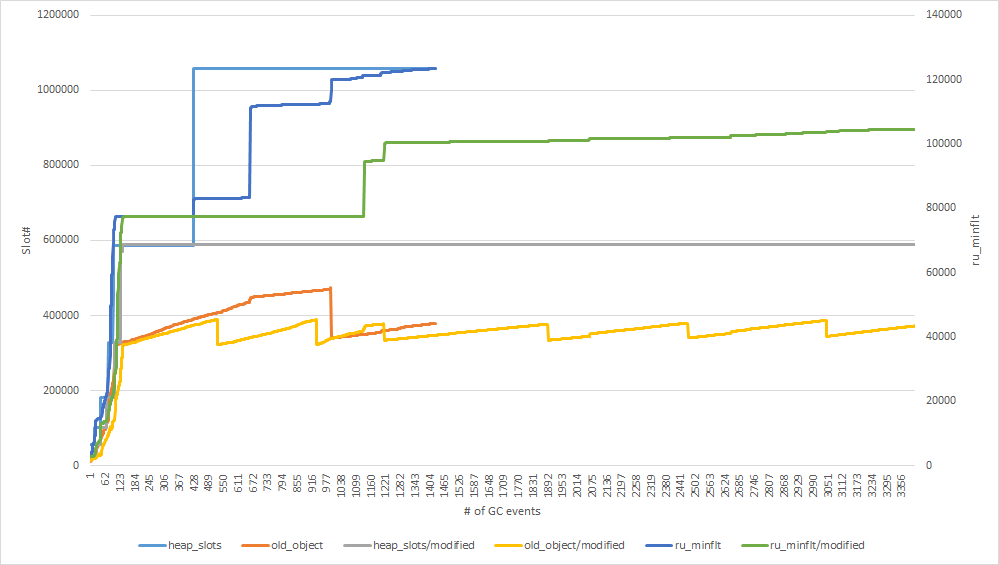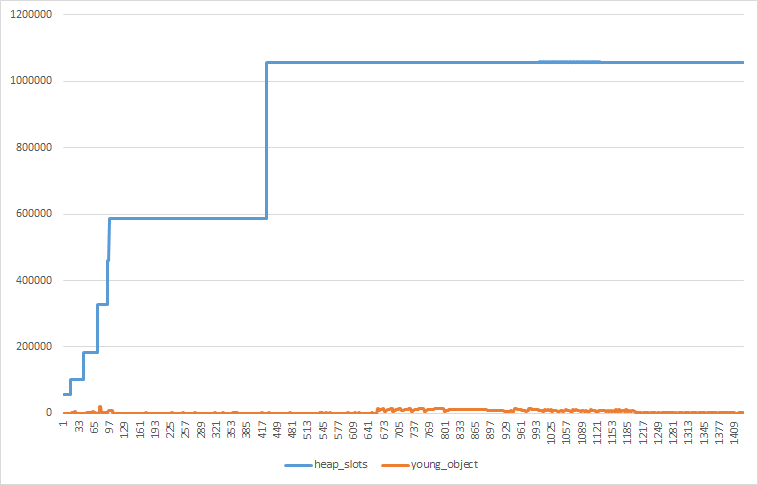Bug #9607
closedChange the full GC timing
Description
Abstract¶
Generational GC (called RGenGC) was introduced from Ruby 2.1.0. RGenGC
reduces marking time dramatically (about x10 faster). However, RGenGC
introduce huge memory consumption. This problem has impact especially
for small memory machines.
Ruby 2.1.1 introduced new environment variable
RUBY_GC_HEAP_OLDOBJECT_LIMIT_FACTOR to control full GC timing. However,
this solution is not solve problem completely.
To solve this issue, we modify Full GC timing strategy:
(1) Always invoke full GC before extending the heap.
(2) Increase the heap if not enough old-objects space.
This modification introduces a bit slow down, but reduce memory
consumption.
Background and problem¶
RGenGC algorithm¶
Ruby 2.0 and earlier versions uses simple mark and sweep. Long marking
time had been an big issue. To solve this issue, Ruby 2.1.0 introduced
new generational GC called RGenGC (restricted generational GC).
RGenGC algorithm enables to introduce partial marking (called minor GC'), which marks only newer created objects, and skips marking fof old objects (*1). Sometime, this marks all objects (called major GC' or
`full GC'). Many minor GC and small number of major GC makes GC faster.
(*1) RGenGC doesn't skip sweeping for old-objects. This is another issue.
Full GC timing¶
There is a question: "When should we invoke invoke full GC?".
Usually, generational GC uses the strategy that "when a space for old
objects is full, then invoke full GC".
Ruby 2.1.0 defines the size of old space for old objects with
old_object_limit' and old_object_limit is doubled by the old objects number (old_object_count') at the last full GC.
Before the GC, we determine minor or major by comparing
old_object_limit' and current old objects number (old_object_count')
if we compare current old object number and old_object_limit, and do
full GC if old_object_count > old_object_limit.
Here is a pseudo code of RGenGC:
def gc
if old_object_count > old_object_limit
major_gc = false
minor_mark()
else
major_gc = true
major_mark()
end
sweep() # Actually it is lazy sweep.
# double `old_object_count' here when it is major GC
old_object_limit = old_object_count * 2 if major_gc
end
This strategy works fine for memory rich machines, because only a few
full GCs are invoked.
However, this strategy causes more and more memory consumption.
Fig.1 is a result of (modified) discourse benchmark (Thanks Sam
Saffron!!). X-axis is GC count and Y-axis represents a number of slots
(objects). total_slots' is avaialbe slots to use, old_object' is
old_object_count.
As you can see, old_object_limit is too high and total_slots are
expanded (x1.8, specified by GC_HEAP_GROWTH_FACTOR) before full GC.
Full GC timing tuning from Ruby 2.1.1¶
To solve this issue, Ruby 2.1.1 introduced an environment variable
"RUBY_GC_HEAP_OLDOBJECT_LIMIT_FACTOR" (use `old_object_limit_factor' for
short).
This variable control how to extend `old_object_limit'.
In pseudo code, we changed from
# double `old_object_count' here when it is major GC
old_object_limit = old_object_count * 2 if major_gc
to
# double `old_object_count' here when it is major GC
old_object_limit = old_object_count * old_object_limit_factor if major_gc
The default value of this environment variable is 2. So it is same
behavior on default.
With RUBY_GC_HEAP_OLDOBJECT_LIMIT_FACTOR=1.3, the benchmark result is
Fig.2.
We can observe that the total slots doesn't grow than the default
behavior.
Try this environment variable if you have trouble with memory usage.
Note that if you want to disable generational garbage collection, you
can specify 0.9 (any number lesser than 1.0) for
RUBY_GC_HEAP_OLDOBJECT_LIMIT_FACTOR. With this technique, on every GC
"old_object_count > old_object_limit" is true and do major GC.
BTW, this variable should be noted on NEWS file. I missed to add it.
More intelligent approach¶
"RUBY_GC_HEAP_OLDOBJECT_LIMIT_FACTOR" with small number can solve this
issue, but we need to specify correct value for each application. It is
tough work for us.
Proposal¶
With these graphes, we find two insights.
(1) We need to invoke full GC becore expanding heaps. If we invoke full
GC, it is possible to stop expanding heaps.
(2) Increasing speed of old objects is completely slow.
To invoke full GC before expanding, we set a upper bount for
old_object_limit as "total_slots * 0.7". This value is same as the
threshold to determin expanding heaps or not.
After full GC, it is possible that "old_object_count > old_object_limit"
is true, but only a few differences. This situation causes many of full
GC. To avoid such situation, we add a few slots if "old_object_limit *
0.7 < old_object_count). In this case, "old_object_limit * 0.7" is a
minimum space for old objects.
In pseudo code:
def gc
if old_object_count > old_object_limit
major_gc = false
minor_mark()
else
major_gc = true
major_mark()
end
sweep() # Actually it is lazy sweep.
if major_gc
if total_slots * 0.7 < using_slots
# not enough space
extend_heap(total_slots * (1.8 - 1)) # 1.8 is growth_factor
elsif old_object_limit * 0.7 < old_object_count
# not enough old object count
extend_heap(old_object_count - object_limit * 0.7)
end
else
do_major_gc_at_next_gc = true
end
if major_gc
a = old_object_count * old_object_limit_factor
b = total_slots * 0.7
old_object_limit = [a, b].min
end
end
With this proposal, we can reduce total_slots consumption (Fig3, Fig4).
However, more and more GC invoking time. It is trade-off because
reducing total_slots introduces more frequent GC. We can solve this
issue by making condition parameter 0.7 as tunable.
Future work¶
(1) Promotion strategy
Current growing speed of old object number is too high. So we need to
consider about promotion strategy. Current strategy is "promote young
objects when young objects survive one garbage collection". We already
implemented "RGENGC_THREEGEN" mode, which enable to filter unexpected
promotion.
NOTE: THREEGEN = 3gen is strange name because generation is only two. We
will change this mode name to AGE2PROMOTION and so on.
(2) Partial sweep
We successed to use partial marking on minor GC. However, everytime
sweep all available slots. Sweeping time is not so big, but there is a
space to optimize it.
(3) Incremental major GC
With this proposal, we increase major GC count. To avoid long major GC
pausing time, we need to implement incremental marking on full GC.
Files

